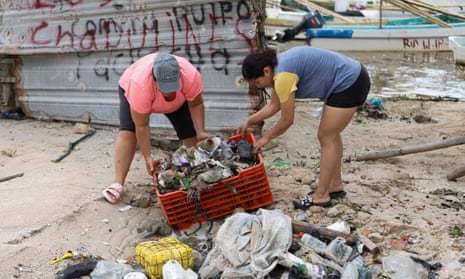Milton forecast to be category 4 storm with 130 mph winds upon landfall late Wednesday or early Thursday
The latest update from Hurricane Center (NHC) states that at 5am local time Hurricane Milton was still a category 5 hurricane with winds of 160mph (260km/h), and was located about 300 miles (480km) south-west of Tampa.
The forecast is now that when it makes landfall it will have fallen to a category 4 storm, with sustained wind speeds of near to 130mph.
Landfall is expected along the west-central coast of Florida late tonight or early Thursday morning, with the storm progressing to move off the east Florida coast on Thursday afternoon.
The storm is currently moving northeast at 14mph, and outer bands have already begun affecting Florida.
Key events Show key events only Please turn on JavaScript to use this feature
Derek Van Dam, presenting the latest forecast on CNN, has said he has “sobering words” as he announced “this did not weaken overnight.”
He said “We are only a matter of hours until we experience tropical storm force winds in this region, and it’s only a matter of hours before we start to see the water levels start to come up,” describing Hurricane Milton as “one of the most powerful top ten Atlantic basin hurricanes to ever form.”
The Orange County sheriff’s office has posted to social media to reiterate to the community that “Life threatening, devastating flooding is forecast along the I-4 corridor.”
It continues “Many tornadoes are possible this afternoon and tonight, especially in organised rain bands. Hurricane force winds arrive tonight into Thursday, along with an increasing threat for storm surge.”
Look closely at these maps. Understand the dangers #HurricaneMilton will bring to our area. Take precautions to protect yourself and your family.
From @NWS:
Oct. 9, 5 AM | #Milton remains a catastrophic category 5 hurricane this morning, forecast to make landfall as a dangerous… pic.twitter.com/x1Et25utos
Hillsborough County sheriff Chad Chronister, speaking on CNN, has said it is “the 11th hour” for people to evacuate from the path of Hurricane Milton.
Chronister, whose county includes Tampa, told viewers “This is the 11th hour. If you’re in an evacuation zone, the time to get out is now. We already saw some flooding out here early this morning. That’s only going to get worse.”
Gabrielle Canon offers this analysis on how US emergency crews are struggling as the climate crisis fuels “unprecedented” competing disasters …
Travel by air will be limited during Hurricane Milton. Tampa international airport halted flights Tuesday morning, and nearby St Pete-Clearwater international airport is in a mandatory evacuation zone and closed after the last flight left Tuesday.
Orlando international airport, Florida’s busiest, is about 84 miles (135 km) inland from Tampa, and said it would cease operations Wednesday morning. The last flights out at the moment appear to be scheduled for 8.15am, with all subsequent departures cancelled.
Tony Marrero, writing for the local Tampa Bay Times, has described residents waking up “on the razor’s edge of a nightmare scenario as Hurricane Milton churns closer to the Gulf Coast.”
He reports that the Tampa Bay area remains in the cone of uncertainty in the latest forecast, and that the peak storm surge forecast for the region remains up to 15 feet.
Our community team are keen to hear your experiences if you are being affected by Hurricane Milton. Of course, your safety and security are most important, and you should put your welfare and the welfare of others first if you are recording, or sharing your content with us. You can find out how to get in touch here …
Milton forecast to be category 4 storm with 130 mph winds upon landfall late Wednesday or early Thursday
The latest update from Hurricane Center (NHC) states that at 5am local time Hurricane Milton was still a category 5 hurricane with winds of 160mph (260km/h), and was located about 300 miles (480km) south-west of Tampa.
The forecast is now that when it makes landfall it will have fallen to a category 4 storm, with sustained wind speeds of near to 130mph.
Landfall is expected along the west-central coast of Florida late tonight or early Thursday morning, with the storm progressing to move off the east Florida coast on Thursday afternoon.
The storm is currently moving northeast at 14mph, and outer bands have already begun affecting Florida.
Here is some footage from the town of Treasure Island in Florida, which shows already deserted streets as Hurricane Milton approaches.
Adria R Walker reports for the Guardian that when people don’t flee their homes due to weather crises despite warnings from government officials, there are typically two reasons why. That is according to Cara Cuite, an assistant professor in Rutgers University’s department of human ecology. She said they either don’t believe they’re at risk or that the risk is overblown, or there are situational or structural elements that prevent them from doing so.
In the case of Hurricane Milton, Cuite said the former group is probably pretty small, as Tampa’s mayor, Jane Castor, and other trusted officials have been unequivocal about the dire consequences of staying.
For the second group, factors can be the cost of travel, having nowhere to go, the impact of a disability, caring for animals and pets, of the fear of permanent displacement.
You can read more here: Hurricane Milton – what does it actually take to evacuate during a weather crisis?
This picture, taken from a drone, shows clouds over the Caloosahatchee River as Hurricane Milton approaches Fort Myers.

This view shows traffic on Interstate 75, near Naples, as people evacuated yesterday evening.

In some areas it has become a struggle to get gas, with ABC News reporting that 30% of gas stations in the Fort Myers and Naples area have already run dry.
6 million people across 11 counties in Florida under mandatory evacuation orders
Reena Roy, reporting from Tampa for ABC News, has said that about 6 million people across 11 counties in Florida are now under mandatory evacuation orders, and that time is running out to make preparations.
She reported that in St Petersburg, residents near construction sites had been warned to relocate, having been told there isn’t enough time left to secure cranes and other construction equipment. Ten hospitals, she said, have evacuated patients, with ambulances travelling from as far afield as Missouri.
She said that authorities have been driving through coastal areas warning people to move while they still have time, and the mayor of Bradenton, Gene Brown, had warned those staying behind to write their own names on their arms for identification purposes. He added “We can replace your home. We can’t replace your life.”
Thousands of national guards have been mobilized, and 34 search and rescue planes are on standby. 37,000 linemen are either in Florida or on the way to help with power outages, Roy reported.
As Milton made its way toward Florida, it was about 125 miles (205 kilometers) northeast of Progreso, Mexico.
Milton brought heavy rain and some flooding to Mexico’s Yucatan peninsula on Tuesday but authorities reported only minor storm damage.
Power lines, light poles and trees were knocked down near the coast, and some small thatched-roof structures were destroyed, according to Yucatan officials.


Hurricane Milton is hurtling towards Florida less than two weeks after Hurricane Helene lashed the state’s coastline.
It’s the kind of double hit becoming more common as the climate crisis persists, further complicating hurricane preparation, experts say.
Milton is forecast to batter Florida’s Gulf coast this week. It’s the third most powerful hurricane in US history, federal officials told reporters on Monday.
The storm could drop 15in of rain on some parts of Florida, with life-threatening storm surges of up to 12ft expected in the city of Tampa. Helene killed a dozen people in the Tampa area.
How did Hurricane Milton reach category 5 strength so quickly and when will it make landfall?

Oliver Milman
How strong has Hurricane Milton grown?
With swaths of the US south still reeling from the disastrous Hurricane Helene, the rapid advance of Hurricane Milton has caught many off guard.
Within barely a day, Milton went from a tropical storm to a category 5 hurricane, one of strongest storms to ever menace the US. Milton eased slightly to a category 4 storm amid mass evacuations of the Tampa area on Tuesday. Milton later strengthened to a category 5 storm again.
“This is nothing short of astronomical,” said Noah Bergren, a Florida-based meteorologist. “This hurricane is nearing the mathematical limit of what Earth’s atmosphere over this ocean water can produce.”
How did it get so strong so quickly?
As hurricanes form, their strength is determined by a number of factors such as thunderstorms and wind shear that can disrupt the tight circular organization of the storm.
A key determinant of rapid intensification, though, is the heat content of the ocean and atmosphere. Hotter air and water provides greater energy to a storm, making it spin faster and ladening it with more moisture that is then dumped onto communities in torrents of rainfall, causing flooding.
When will Hurricane Milton make landfall?
Milton is expected to make landfall on Florida’s central Gulf coast late Wednesday. Forecasters said Tuesday that although it will likely fluctuate in intensity, Milton will remain “an extremely dangerous hurricane” through landfall.
As of Tuesday afternoon, Milton was about 520 miles (835km) south-west of Tampa with sustained winds of 155mph (250kph).
Joe Biden, who postponed an overseas trip so he could remain at the White House to monitor Milton, warned that it “could be one of the worst storms in 100 years to hit Florida”.
Biden warned Milton could be one of worst storms in US for 100 years
Joe Biden said on Tuesday that Hurricane Milton could be one of the worst storms in the US for 100 years and advised residents to leave immediately as “a matter of life and death”.
The US president also told reporters at an event in Wisconsin that his team was doing everything they could to help save lives and protect communities:
We’re prepared for another horrible hurricane to hit Florida. I directed my team to do everything they can to save lives and help communities, before, during and after this hurricane. The most important message today for all those who may be listening to this and the impacted areas: listen to the local authorities. Follow safety instruction, including evacuation orders.
Florida’s western coast is making emergency preparations on Wednesday morning for the impact of Hurricane Milton, with thousands of evacuees clogging highways, contending with fuel shortages, and facing blunt warnings that “you are going to die” if they stayed behind.
The US Hurricane Center (NHC) said Milton would retain major hurricane status and “expand in size” as it approached Florida after passing the Mexican city of Mérida before swerving north towards the US.
The eye of the storm closed overnight on Monday, and winds slowed slightly, before reorganizing as an “extremely dangerous” 155mph (250km/h) category 4 hurricane. As of Tuesday afternoon, the storm had restrengthened to a category 5 in the Gulf of Mexico.
With up to 15ft (4.5 metres) of life-threatening storm surge, Milton has the potential to be “one of the most destructive hurricanes on record for west-central Florida”, the NHC said.
Welcome and opening summary …
Welcome to our rolling coverage of Hurricane Milton, as it is expected to make landfall in Florida. The Hurricane Center has predicted Milton, a Category 5 hurricane during much of its approach, would likely weaken but remain a major hurricane when it makes landfall late Wednesday.
The Tampa Bay area, home to more than 3.3 million people, faced the possibility of widespread destruction after avoiding direct hits from major hurricanes for more than a century. Thousands of evacuees have been clogging highways, contending with fuel shortages, with the mayor of Tampa warning residents bluntly “you are going to die” if they stayed behind.
Almost all of Florida’s west coast was under a hurricane warning, with more than a million people told to evacuate, fleeing potentially catastrophic damage and power outages that could last days.
We’ll bring you the latest updates …

 1 month ago
1 month ago

















